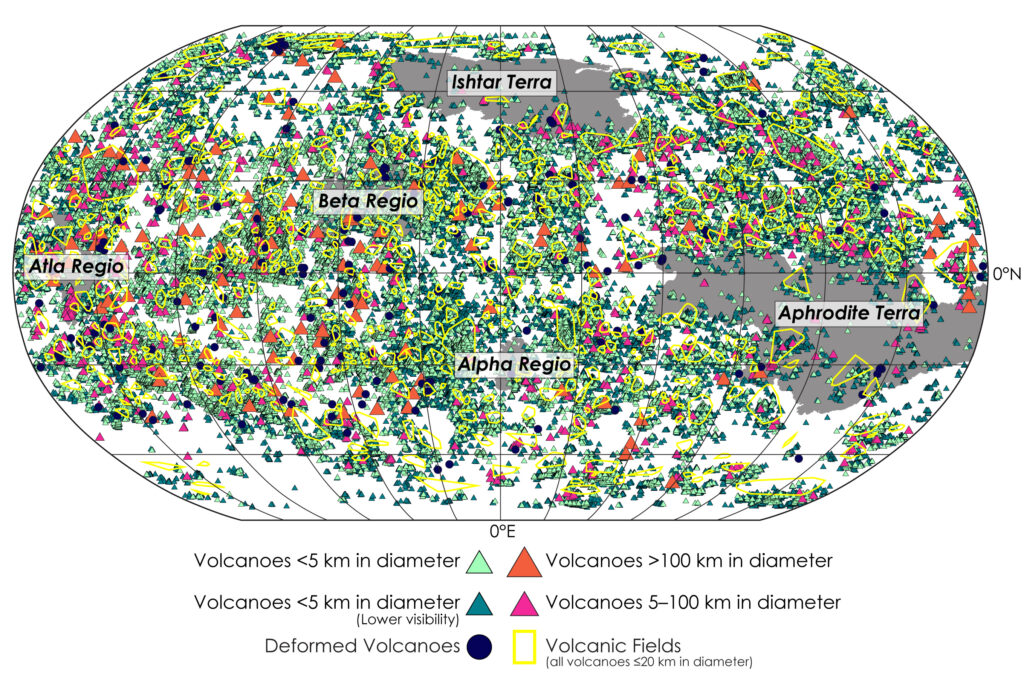A new map created with decades-old radar imagery from NASA’s 1990’s Magellan mission shows the locations of a whopping 85,000 volcanoes on Venus. The detailed map displays where the volcanoes are, how they’re clustered, and how their distributions compare with other geophysical properties of the planet such as crustal thickness. This comprehensive study of Venus will help planetary scientists answer many outstanding questions about the planet’s geological history, such as why doesn’t it have plate tectonics like Earth? Was it ever habitable, and if so, for how long? Sapas Mons, a large volcano on Venus, is about 400 km in diameter.
It was imaged by the Magellan spacecraft, with a light source coming from the left side of the image. (Image courtesy of JGR Planets) This is the second major finding from archival Magellan mission data, as just a few weeks ago scientists announced they found evidence of recent active volcanism on Venus. The authors of this new paper, graduate student Rebecca Hahn, and Paul Byrne, an associate professor of earth and planetary sciences, both from Washington University in St.
Louis, say their new map can help locate the next active lava flow on Venus, and more. “This paper provides researchers with an enormously valuable database for understanding volcanism on that planet — a key planetary process, but for Venus is something about which we know very little, even though it’s a world about the same size as our own,” said Byrne, in a press release. It has long been known that volcanism has been a major, widespread process on Venus.
And even if 85,000 volcanoes on Venus sounds like a large amount, Hahn said it is probably a conservative number. She believes there are hundreds of thousands of additional geologic features that have some volcanic properties lurking on the surface of Venus. However, they’re just too small to have been picked up by Magellan’s synthetic-aperture radar (SAR).
Building this global map was tedious work, as Hahn pored through the planetary radar scans captured by Magellan. On Twitter, Byrne said this took years of work by Hahn. But she also took advantage of new technology.
“It was tedious, but I had experience using ArcGIS software, which is what I used to build the map,” Hahn said. “That tool wasn’t available when these data first became available back in the ’90s. We came up with this idea of putting together a global catalog because no one’s done it at this scale before.
” Image of “pancake volcanoes” located in the Eistla region, taken by the Magellan space probe. Credit: NASA/JPL In working with the data, the researchers found that Venus is home to thousands of volcanic landforms, distributed across virtually the entire planet. The volcanoes range in size from much less than 5 km (3 miles) to well over 100 km (60 miles) in diameter.
However, 99% of Venus’ volcanoes are smaller than 5 km (3 miles) in diameter. “Although there are volcanoes across almost the entire surface of the planet, there seem to be relatively fewer volcanoes in the 20–100 km [12-60 mile] diameter range, which may be a function of magma availability and eruption rate,” the researchers wrote in their paper — (which is free to read online until early May 2023. ) While Venus is nearly the same size and composition of Earth, it doesn’t have plate tectonics, so all Venus’ internal heat likely emerges through its volcanoes.
How does the amount of volcanoes on Venus compare with Earth? Right now, there are about 1,350 potentially active volcanoes on Earth, but the amount under the ocean is not well known. We also don’t know how many volcanoes have been active over Earth’s history. Of course, Venus is without oceans and without weathering to change planet’s surface.
But we do know that more than 80 percent of the Earth’s surface–above and below sea level–is of volcanic origin. The new Venus volcanoes dataset is hosted at Washington University and publicly available for other scientists to use. “We’ve already heard from colleagues that they’ve downloaded the data and are starting to analyze it — which is exactly what we want,” Byrne said.
“Other people will come up with questions we haven’t, about volcano shape, size, distribution, timing of activity in different parts of the planet, you name it. I’m excited to see what they can figure out with the new database!” The post We Now Have a Map of all 85,000 Volcanoes on Venus appeared first on Universe Today. .
From: universetoday
URL: https://www.universetoday.com/160832/we-now-have-a-map-of-all-85000-volcanoes-on-venus/
